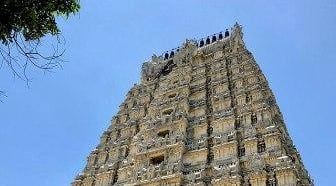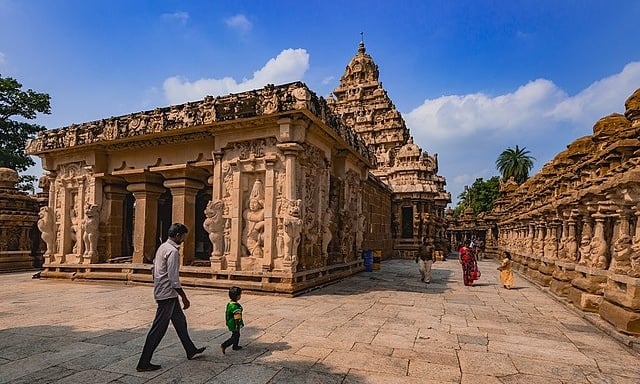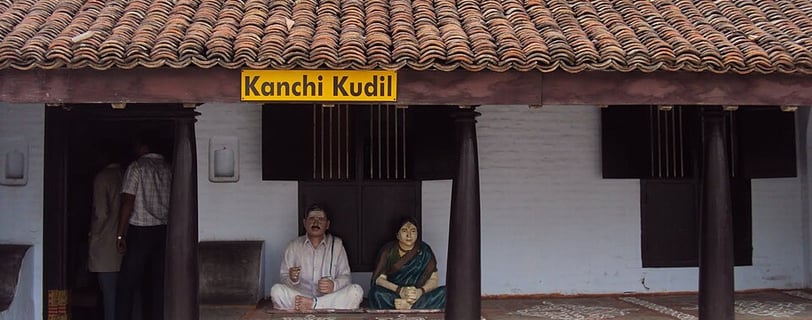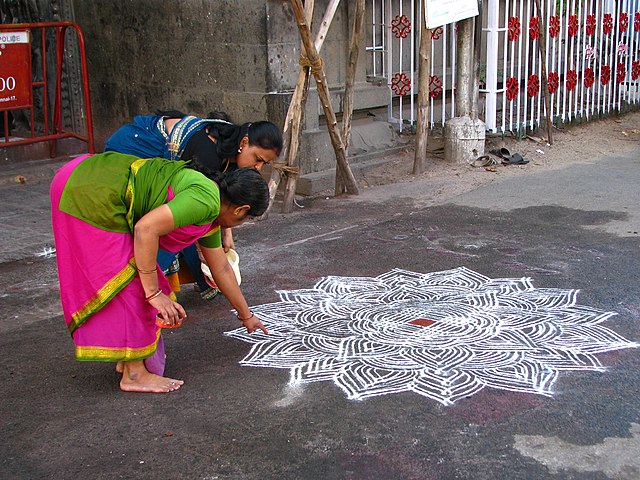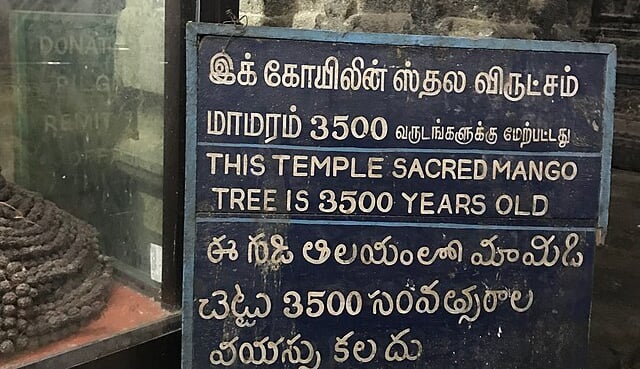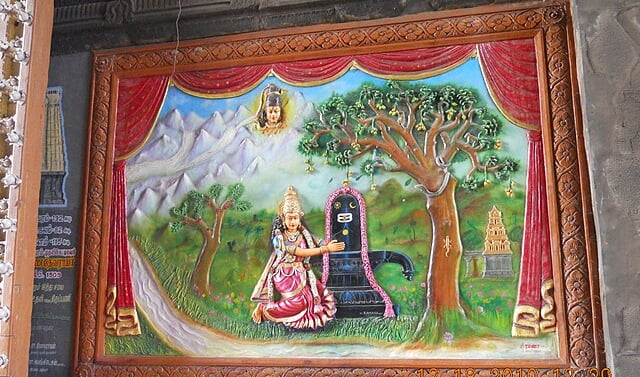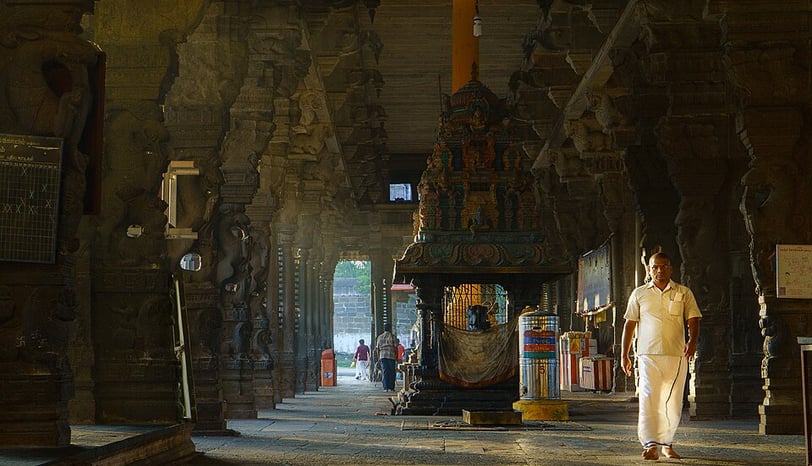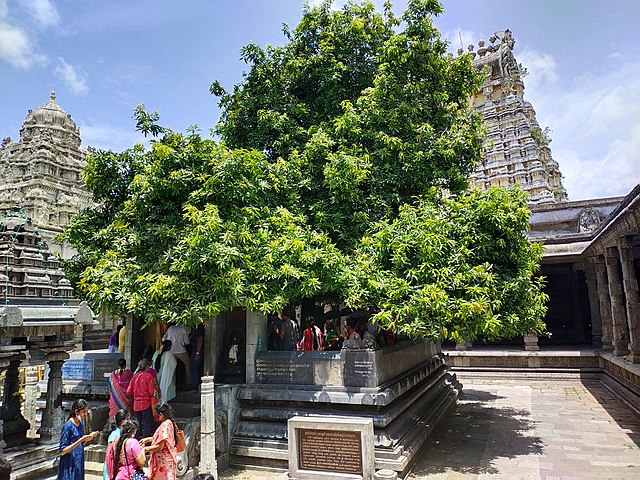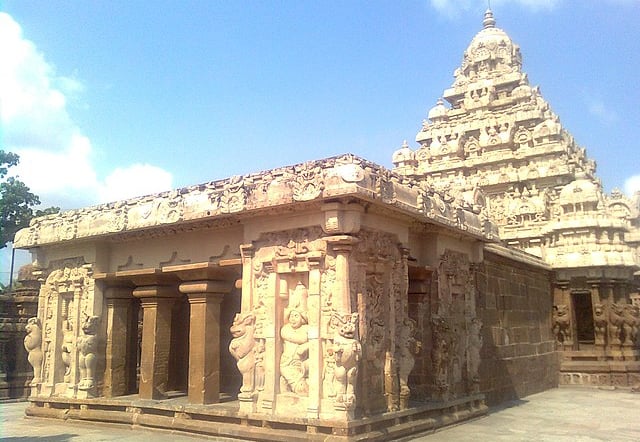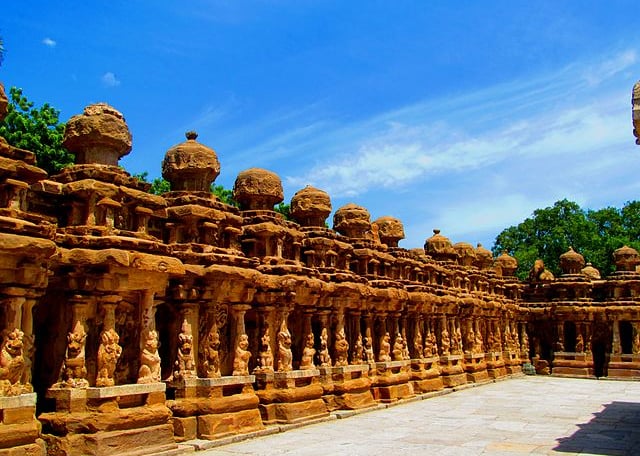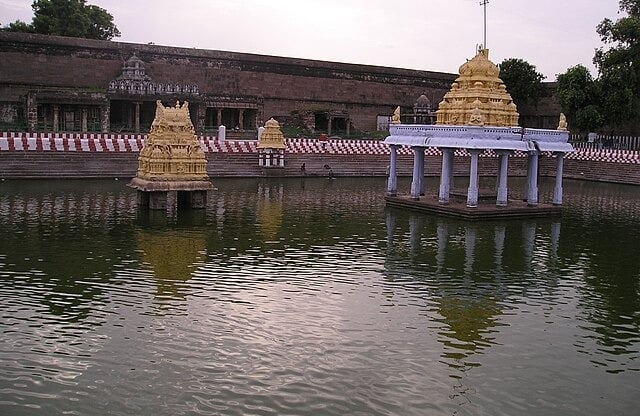CHIAMA/WHATSAPP: +91 6304795901 OPPURE SCRIVICI ALL'INDIRIZZO E-MAIL contact@wanderwise.me
EXPLORE KANCHIPURAM: TEMPLES OF PALLAVA DYNASTY
Discover Kanchipuram, the ancient capital of the Pallava dynasty, famous for its stunning temples that reflect Jain, Buddhist, and Hindu traditions. Immerse yourself in the rich heritage and history of this fascinating city.
5/22/202539 min leggere
THE TEMPLES OF KANCHIPURAM
INTRODUCTION
Do you know how fascinating the town of Kanchipuram really is? Let me show you a side most visitors miss.
Just a two-hour drive from your hotel in Chennai, is one the seven sacred towns of India, Kanchipuram —an ancient tapestry of temples, silk, and spiritual serenity. As you leave the city’s chaos behind, the landscape shifts: concrete gives way to coconut palms, and the highway meanders through semi-rural stretches where emerald paddy fields sway in the breeze. You’ll spot bullocks trudging besides gleaming lorries and patches of farmland occasionally interrupted by the stern silhouettes of industries — industrial zones wedged like bookmarks in a mostly pastoral page.
Thankfully, the journey is dotted with those highway gems: trusty restaurants that offer clean restrooms, smiling waiters, and steaming tumblers of excellent filter coffee.
Kanchipuram—once the vibrant capital of the Pallava dynasty on the banks of the Vedavathi river—was said to house a thousand temples, embracing Jain, Buddhist, and Hindu traditions in a rare architectural & spiritual harmony. In fact, Kanchipuram was one of the most prominent cities in South India, with an estimated population between 20,000 to 50,000 people during the Pallava reign.
Now picture this: a thousand temples for that many people. That’s roughly one temple for every 20 to 50 residents—talk about divine real estate! But don’t let the modest population fool you.
Kanchipuram wasn’t just spiritually loaded—it was also economically lit. This once ranked among the richest capitals in the world. Merchants from across the ancient world came here to trade silk, cotton, spices, salt, and more. And what did they bring in return? Among other things, the Romans casually rolled in with amphorae of wine, because clearly, what’s a business talk without wine—even if the business is empire-building?”
Now, coming to the serious side…..
Sadly, about 900 or so of those temples didn’t survive the 14th century. Between invasions and time doing what time does best—wear things down—only a handful of those sacred spaces still stand. But oh, what a handful they are! The large-scale destruction of temples in Kanchipuram during the 14th century is generally attributed to the invasions of the Delhi Sultanate, particularly under the armies of Malik Kafur, a general of Alauddin Khilji, and later under Muhammad bin Tughlaq.
Of the thousand temples that once graced Kanchipuram’s sacred soil, around a hundred remain today—each one a stone survivor with centuries of stories etched into its walls. But unless you’re planning to stay a month or arrive on a divine chariot with unlimited stamina, you’ve got to be choosy.
If you wish to stay longer and explore more, that’s a different matter altogether. But if you’re doing Kanchipuram on a tight schedule, then according to me, there are two absolute must-sees—and if the coffee kicks in and time is kind, we might just sneak in a third.
Plus, Kanchipuram isn’t just about temples and spiritual tourism—it’s also seriously famous for its handloom silk. We're talking about sarees that are less clothing and more of an heirloom. The weavers here use traditional techniques, including the intricate Jacquard-style weaving, where every motif—be it a peacock, mango, or temple gopuram—is painstakingly punched into cards and woven with love (and a whole lot of skill).
Almost every South Indian bride dreams of at least a couple of wedding sarees from this sacred town. Not just because they’re drop-dead gorgeous, but because they believe sarees woven in Kanchipuram come with divine blessings stitched right into the zari. Fashion meets faith—and the result is stunning.
Oh absolutely—Kanchipuram isn’t just a wedding trousseau treasure trove. There’s plenty for Western tourists to pick up that won’t require a crash course in draping or a crash diet to fit into traditional wear.
Bonus: A Quick Crash Course in Kanchipuram Weaving when you visit the shops-cum-looms
After a day of temple hopping and fabric fondling, it’s only fair that your taste buds get their own pilgrimage. Wonderful vegetarian options await you; including food served on banana leaves and love.
Exciting? Let’s explore the temples first.
Note: The seven sacred towns in India are; Kashi (Varanasi), Kanchipuram, Ayodhya, Mathura, Hardwar, Ujjain & Dwarka.
Did you know? Bodhidharma, (the Chinese affectionately call him Damo) originally a Pallava prince from Kanchipuram and heir-apparent to the throne, made a remarkable decision to abdicate his royal position in favour of his brother and embark on a journey that would change the course of history. Leaving behind his princely life, Bodhidharma traveled all the way to China. After nine years of intense meditation, facing the cave wall in profound solitude, he dedicated himself to spreading the teachings of Buddhism to those who sought spiritual enlightenment.
However, Bodhidharma's contributions weren’t limited to spiritual teachings alone. Observing that the monks were physically weak and vulnerable to external threats, he founded the Shaolin Monastery. There, he taught the monks Kung Fu, though, he often emphasized that martial arts were a secondary concern. The true essence of his message was the practice of Dhyan, or meditation, which was central to his version of Buddhism. Over time, the term “Dhyan” was mispronounced Chan in China, and later, when it reached Japan, it evolved into what we now know as Zen.
Once you roll into Kanchipuram, chances are your first holy pilgrimage won’t be to the temple—but to a toilet. Let’s be honest, after that bumpy ride, your inner peace might depend on a quick comfort stop. Fear not, salvation is near!
Just a stone’s throw from the temple is a delightful detour called Kanchi Kudil—a charming 100-year-old heritage house that’s basically a living museum. But here’s the secret: it's also your loo with a view (of culture that is).
Instead of ducking into a modern café or restaurant, step into this vintage gem that showcases traditional Tamil architecture. Kanchi Kudil isn’t just beautiful at your feet—it’s charming right to its rooftop, where you’ll spot those classic terracotta tiles. These aren’t just for rustic appeal—they're functional, laid with an extra insulating layer to keep the house cool in the sweltering Tamil Nadu sun. No AC? No problem. The roof itself has your back (and your scalp) covered. Smart design, centuries before “eco-friendly architecture” became a buzzword.
A NOTE ON READING MY BLOG
Considering the wonderfully diverse mix of visitors these temples attract—from Chennai locals on their daily rounds to international travellers experiencing their first South Indian shrine—I’ve tried to pack in as much essential information as possible. This blog aims to be both a practical guide and a cultural companion, blending historical context, architectural insights, spiritual nuances, and everyday observations.
I’ve made a conscious effort to strike a balance between catering to domestic readers who may already be familiar with many of the rituals and traditions, and international visitors who may be encountering them for the first time. For instance, some practices—like entering the inner sanctum (Garbhagriha)—are reserved for Hindus only, which can come as a surprise to some foreign visitors. I’ve flagged such moments to help you navigate with awareness and respect, without feeling lost or awkward.
That said, feel free to cherry-pick the parts of this blog that resonate most with you. Whether you're here for the architecture, the photography, the spiritual atmosphere, or just a great cultural story, there's something in these temples for everyone. If the whole post doesn’t hold your attention, no worries—dip into what interests you most, and skip the rest. After all, exploring the temples should feel like a discovery, not a checklist.
GETTING THERE: LOCATION, TRAVEL TIPS & TIMINGS
Kailashnath temple Kanchipuram Photo by Bikash Das from Wikimedia commons licensed under CC by SA-2.0
Kanchi Kudil by Destination8infinity from Wikimedia commons licensed under CC BY-SA 2.0
The rooms unfold one after the other like a vintage train whose compartments are connected by a vestibule —no ticket required—and at the very end of this heritage express is your final destination: a clean, surprisingly well-kept toilet.
Bonus: they usually have toilet paper. But, as any seasoned traveller knows, “usually” is a dangerous word. So stash a little extra tissue in your bag. While you might be ready for divine darshan, your digestive system may have other plans.
As you make your way to the rear-end (pun intended), you’ll pass through charming rooms filled with ancient wooden furniture, a traditional swing that’s practically begging for an Instagram moment, and shelves of divine knick-knacks.
Some items are actually for sale—so if you’ve ever wanted to pick up a deity or two on your way to spiritual glory, this is your chance.
If you have been rushing to be the first person to reach the toilet, you might have overlooked the Kolam design on the floor outside the house. On the way don’t miss it.
On the way in or out don’t forget to look down—no, not out of reverence, but to admire the Kolam at the entrance. This beautiful geometric floor art, drawn fresh every morning, isn’t just for show—it pulls quadruple duty.
1. Morning Mood-o- Meter:
For the lady of the house, it’s her first creative act of the day. If last night was peaceful and drama-free, expect an elaborate masterpiece worthy of an art gallery. If there were… let’s say “domestic discussions,” you might get something a little more minimalist. Either way, it's her quiet ritual to start the day with intention.
2. Divine and Human Welcome Mat:
Kolams are essentially invitations—to both guests and gods. It’s Tamil hospitality written in rice flour: “Please enter, but only if you're kind and bring good vibes.”
3. Ant-Approved Altruism (or Antruism should I say?):
Traditionally made with rice powder, kolams also serve as breakfast for ants. It’s a humble act of charity—even the tiniest life forms get their share. (Relax; we’re not talking about Jurassic Park-style killer ants.) That said, in today’s economy, rice is a luxury for many low-middle-class households. So most now use white mineral chalk. Sorry ants—you’ll have to get your carbs elsewhere.
4. Apotropaic Magic (Say What Now?):
Yes, here’s your new vocabulary flex: apotropaic. It’s a fancy Greek word that means “to ward off evil.” The Kolam, in this sense, isn’t just decorative—it’s a symbolic force field against misfortune, negativity, and random acts of cosmic mischief.
Kolam by McKay Savage from Wikimedia commons under licensed under CC BY-SA 2.0
Alright, you've admired the Kolam, nodded appreciatively at the terracotta rooftop, used the toilet (hopefully with toilet paper), and maybe even bought a small brass Ganesha you didn’t know you needed. Now it's time to do what you actually came to Kanchipuram for: visit the temple.
Temple Timings: 6.00 am to 12.30 pm & 4.00 pm to 8.00 pm & 6.00 am to 10.00 pm (On functions and ceremony days)
EKAMBARANATH TEMPLE - KANCHIPURAM
Discover the majestic Ekambareshwara Temple in Kanchipuram (a.ka. Ekambaranathar Temple & Other variants you might occasionally see include: Ekambareswarar Temple, Ekambaranatha Swamy Temple) a revered Shiva temple in Tamil Nadu known for its ancient architecture, sacred mango tree, and spiritual heritage. The Ekambareswarar Temple Kanchipuram is one of the Pancha Bhoota Stalas, representing the element Earth – a must-see among South India's famous temples. It is one of the 275 temples glorified in the Tevaram hymns composed by the Tamil Saivite saints Appar, Sundarar, and Thirugnanasambandar. This makes it not only architecturally significant but also spiritually revered in Shaivite tradition.
PARKING: WHERE TO LEAVE YOUR VEHICLE
If you're driving yourself or have hired a car (bless your air-conditioned soul), there's a neat little parking space tucked inside the temple complex—yes, actual parking space in India. But if you're arriving like most pilgrims—on foot, in an auto, off the nearest local bus stop or on a larger bus—you’ve got a 200-meter spiritual warm-up walk ahead of you. Don’t worry though. It’s not just any old walk. It's a meandering maze of silk and snacks. On both sides, the path is flanked by shops stacked with shimmering Kanchipuram sarees that practically call out, “Buy me, or forever regret it.” Even if you have no budget or intention, you will stroke a saree and say something vague like, “So soft!”
And then come the cart vendors, tempting you with everything from melt-in-your-mouth sweets & savouries and bags of puffed rice—not just for munching, but also to feed the fish in the temple tank. Just when you're halfway through a packet of sugar-coated something, you look up—and there it is. The Gopuram. Looming large. Majestic gopuram posing for the ultimate celestial yearbook photo. It doesn’t just dominate the skyline—it demands attention. It's as if the temple itself is saying, “You've arrived, mortal.”
FOOTWEAR ETIQUETTE & DRESS CODE: TO KNOW BEFORE YOU GO
Now, business as usual—and by that we mean: no footwear allowed inside the temple. From now on it is sacred ground. Socks? Technically okay. I mean it you don’t mind getting it dirty.
Now here’s the catch—there's no grand, organized shoe stand with numbered tokens and polite staff. Nope. This is the DIY shoe-drop system. That’s why cheap sandals are suggested.
You've got two main options:
Find a tiny shop selling pooja thalis—those shiny steel or woven cane plates filled with flowers, camphor, bananas, a coconut, and a prayer or two. They’ll usually let you leave your shoes near the entrance if you're buying something… or even just flashing a respectful smile and tacitly implying you’ll tip them on the way back. (No words — just a subtle eyebrow raise and the classic Indian head tilt.)
2. Or just leave your footwear discreetly near the camera ticket kiosk—yes, there’s a separate little booth where you pay to take photos inside. The space beside it doubles as an unofficial community footwear pile.
Now, barefoot or sock-footed, you’ve got another 75-meter walk before you hit the actual temple threshold. It’s a peaceful little stretch, where the sounds of honking autos fade, and you’re greeted by the echoes of temple bells, distant chants, and the fluttering pigeons that’ve clearly made the gopuram their rent-free home.
Dress code: Long trousers that cover the ankles and no sleeveless tops are expected. In short—dress modestly, please. You might spot people wandering in with shorts and T-shirts, but temple rules tend to change faster than a monsoon cloud over Chennai. It’s always safer (and more respectful) to err on the side of tradition.
Before you proceed any further—pause. Turn around and take in the view of the gopuram from inside the temple walls.
THE TEMPLE: HISTORY, ARCHITECTURE & CULTURAL SIGNIFICANCE
The temple was originally built by the Pallavas from the 7th – the 9th centuries in typical Dravidian style architecture. From the 9th to 12th centuries, the Chola dynasty made significant additions and renovations. The big stuff happened during the period of Vijaya Nagar Empire (14th to the 17th century). The Raja-gopuram (the Royal gateway tower) which is 59 meters high was built during this period.
Legend has it that this very temple stands on the sacred spot where none other than Shiva and Parvathi tied the knot—yes, the celestial wedding that set the gold standard for divine unions. There’s actual Carbon-14 dating done on the ancient mango tree under which the ceremony supposedly took place, and guess what? The science checks out. Tree’s legit. Around 3,500 years old.
Mango tree board at Kanchi temple by Ms Sarah Welch from Wikimedia commons under licensed under CC BY-SA 4.0
In fact, Shiva’s name here isn’t just some random divine alias pulled from the celestial name jar. He is worshipped as Ekambarnath—which literally means “Lord of the Mango Tree.”
Parvathi, in classic mythological fashion, gets cursed—because apparently being a goddess doesn’t protect you from cosmic drama. She’s forced to take birth on Earth, live the mortal life, and repent for some long-forgotten celestial faux pas.
Parvathi worshipping by tshrinivasan from Wikimedia commons under licensed under CC BY-SA 3.0
However, even in her earthly form, she remembers who she really is. Eventually, after performing intense penance she gets re-married to Shiva—right here, under that mango tree. So when you stand in the temple and look at that venerable old tree, know this: you're not just looking at botanical history—you're witnessing re-union of cosmic deities.
There’s a belief that if you wish to part of Shiva’s heavenly abode (aka Kailasa), in the here-after, one must visit at least 106 of the 275 Paadal Petra Sthalams (Sacred temples that have been blessed by the hymns of the saints) to qualify for that.
The Ekambarnath Temple is proudly one of these sacred stops. It’s not just a place with towering gopurams and a mango tree older than most civilizations—it’s also a site where something legendary or miraculous is believed to have happened.
So miraculous, in fact, that the Shaivite saints — Appar, Sundarar, and Thirugnana Sambandar — burst into spontaneous religious outbursts of Tamil poetry here.
So whether you’re here for the myth, the mango tree, or just trying to rack up your “Kailasa credits,” this temple checks all the boxes.
Special Note: This temple is so architected that the Sun rays fall directly on the deity inside the shrine on one particular day. If you happen to visit around that time, stick around the sanctum early in the morning. On March 21st, the spring equinox, the rising sun’s rays travel through the multiple mandapams and fall directly on the main Shiva Lingam inside the sanctum sanctorum. No fancy mirrors, no spotlights—just centuries-old precision planning by temple architects who apparently also had a minor in astrophysics. It’s like Shiva gets his personal sunbeam, a cosmic “Good morning!” moment, as if the universe itself is stopping by for darshan. So if you’re there at the right time, don’t blink. The moment is brief, but it’ll give you Goosebumps that last a while.
Note: In the following sections, I offer a “Virtual Walkthrough of the Temple, in Words and Images” —a vivid, step-by-step walkthrough that reveals its many facets in words. If you prefer to experience the temple first hand and let its beauty unfold naturally during your visit, you may wish to skip ahead. For your convenience, I’ve enclosed the virtual tour within red markers.
Exploring the temple - The gopuram (see picture)
Now that you’ve admired the gopuram from both sides—outside, with the street buzz behind you, and inside, framed by ancient stone corridors—it’s time to explore the rest of the temple. Before you move on, you might have noticed something….unusual? This gopuram is white. Yep, half-white, to be precise. A bit of a minimalist in a world of Technicolor temple towers. Unlike the riotously colourful gopurams you might’ve seen in Chennai, dripping with painted gods, demons, dancers, and celestial chaos, the Ekambarnath’s gopuram keeps it relatively simple & subtle. Why? Simple—there just aren’t as many statues to paint. No rainbow riot here.
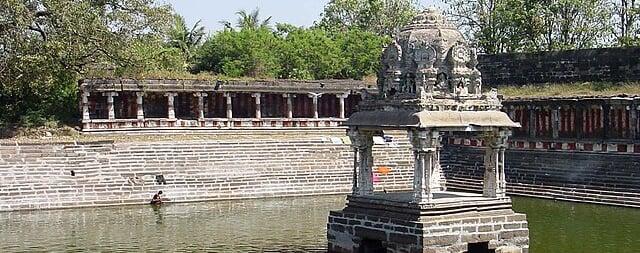

Temple tank by G41m8 Moscow from Wikimedia commons under licensed under CC BY-SA 4.0
Unlike many other temples where the temple tank is located outside the main complex, the tank at Ekambarnath Temple is situated well within the temple precincts. Traditionally, it serves as an ablution tank where devotees descend the steps to wash their hands and feet, sprinkle water upon themselves as a ritual of purification, and offer puffed rice to the fish in the tank—an act of charity extended even to lesser forms of life before proceeding to the shrines.
In recent times, however, the tank is often cordoned off with a chain-link fence to prevent the disposal of waste and maintain cleanliness. While this barrier restricts physical access, it does not obstruct the view, allowing devotees to still take in the presence of the sacred waters from a distance.
Directly opposite the temple tank stands a modest kiosk offering a variety of prasadams—blessed food that has been offered to the deities—including savouries, sweets, and tamarind rice, which is particularly popular among devotees.
At the centre of the mandapam (pillared hall) is the Dwaja Sthambam, or flagstaff. Unlike in many other temples, the full height of the pole is not visible here, as a granite roof has since been constructed around it. Nearby, one can find the Bali Peedam, the altar of sacrifice, uniquely shaped like an inverted lotus, and a small yet revered Nandi, the sacred bull and vehicle of Lord Shiva. To manage crowding and preserve order, the Nandi is enclosed within a protective grill—an effort to deter the long-standing tradition of devotees queuing to whisper their wishes into his ears. But not to worry! A modern twin of Nandi has been thoughtfully installed nearby—consecrated and fully qualified to receive your whispered wishes. He’s like the official backup Nandi, ready to forward your prayers to Shiva when the time is right. Just a friendly caveat: he’s been known to be a bit... selective. There’s a chance your heartfelt wish might enter through one ear and exit straight out the other.
Pro tip: follow the locals' lead—they often cover Nandi’s other ear while whispering, just to make sure the message doesn’t take the express route out.
The coconut-breaking zone & The Dwaja Sthambam
While there's no neon sign saying “Coconut Breaking Zone” at Ekambarnath Temple in Kanchipuram, smashing coconuts is very much part of the spiritual to-do list. Think of it as the divine equivalent of cracking open a piñata—except instead of candy, you get blessings (and possibly a bit of coconut water on your clothes). Devotees usually pick a spot near the main shrines to perform this sacred smash, hoping their problems break as easily as the coconut. It’s devotion with a dramatic flair—and a satisfying thunk.
That said, some devotees like to go deluxe and opt for the full “Puja thali package”—optional, of course, but very on-brand for divine VIP treatment. You hand over your plate of goodies to the priest, who then becomes your spiritual middleman, offering it all up to the gods with the right rituals, chants, and flair. The coconut gets cracked ceremoniously (no DIY smashing needed), and you get it back as blessed food—now officially endorsed by the divine.
The circumambulation
Before entering the main sanctum for the inner circumambulation, it is worth pausing and turning back to observe the far end of the corridor. There, a series of precisely aligned ventilation openings can be seen. On the day of the summer equinox, sunlight passes through these openings at a particular angle, illuminating the deity enshrined within.
This rare and remarkable alignment is not merely architectural—it is deeply symbolic. It represents Surya, the Sun God and embodiment of cosmic rhythm, offering homage to Lord Shiva, the one who transcends time, space, and the very fabric of the cosmos. It stands as a testament to the profound astronomical and spiritual knowledge embedded in the temple's design.
The circumambulatory experience within the Ekambarnath Temple is truly remarkable. On one side, a series of Shiva Lingams are reverently arranged, while on the other, grand wooden palanquins stand in readiness—majestic structures meant to carry the divine images of Shiva and Parvathi through the streets during festive processions. It evokes the image of a royal monarch who, on select occasions, emerges from the sanctum to grace the presence of devotees
Mandapam at Ekambareswarar temple by Roehan Rengadurai from Wikimedia commons under licensed under CC BY-SA 3.0
The entire pathway is lined with 240 intricately carved pillars, showcasing exceptional symmetry and craftsmanship. Each pillar features unique floral and ornamental motifs, reflecting a high level of artistic detail. These designs continue to serve as inspiration for both jewellery and textile patterns, underlining the temple's influence beyond the spiritual realm.
Before stepping inside, take a moment to observe the two door guardians standing sentinel at the entrance. Their stern expressions and imposing presence seem to silently remind all who enter to mind their manners and conduct themselves with reverence. A subtle but effective cue to leave behind any distractions and approach the sacred space with the respect it deserves.
The scared tree of the temple
As you make your way around, bingo! You'll stumble upon the 3500-year-old mango tree, the very spot where the divine wedding of Shiva and Parvathi is believed to have taken place. It’s not just any old tree—this one has witnessed millennia of history. Surrounding this sacred tree, the entire temple complex sprawls over 25 acres (10 hectares), making it a truly expansive site that houses both divine history and architectural splendour.
Mango tree at Ekambareswarar temple by Luistxo from Wikimedia commons under licensed under CC BY-SA 4.0
FESTIVALS & CELEBRATIONS: THE TEMPLE IN FULL SPLENDOR
Mahashivaratri: (February – March) – See my previous blog on Kapaleshwara temple for description of this festival
Panguni Uthiram: Check my previous blog on Kapaleshwara temple about this festival.
Mass weddings happen at the Ekambarnath temple during this festival, and it’s beautifully fitting given the temple’s divine origin story. After all, this is the place where Shiva and Parvathi themselves got married—so it doesn’t get more auspicious than that! The temple is associated with marital harmony, love, and reunion; many devotees believe that tying the knot here brings blessings for a strong and lasting marriage
Chitra Poornima: This festival, held in April, is dedicated to Lord Shiva and is celebrated with grandeur. Special rituals are performed, and the temple is decorated beautifully. Devotees engage in prayers, offerings, and processions around the temple.
Navaratri: This nine-night festival, typically in September or October, celebrates the power and glory of Goddess Durga. Though primarily focused on the goddess, it also includes rituals dedicated to Lord Shiva and other deities within the temple. The festival culminates with Vijayadashami, celebrating the victory of good over evil.
Annual Temple Car Festival (Rath Yatra): The temple car festival is a major event, where the deities of Lord Ekambarnath and Goddess Parvathi are taken out in a grand procession on beautifully decorated chariots. This festival usually takes place during the Tamil month of Panguni (March-April) and is an occasion of immense devotion and celebration.
PHOTOS: WHAT’S ALLOWED, NOT, ANGLES, LIGHT & GOLDEN HOUR
Photo angles & perspective
The Rajagopuram (Main Tower) – The Grand Entrance Shot
Angle: Shoot from a low angle to capture the towering 59-meter gopuram in all its Dravidian glory.
Pro Tip: Morning light works best when the sun hits the detailed sculptures, giving them depth and shadow.
The mandapam (pillared hall in the inner circumambulation)
Angle: Stand at one end of the corridor & capture the perfect linear symmetry.
Pro Tip: Focus & highlight the intricate carvings and unique motifs on each pillar.
The sacred mango tree
Angle: Wide angle shot with the shrine and structures in the background
Drone Photography: If you have access to a drone and the necessary permissions, aerial shots can provide a unique perspective of the temple complex. Ensure compliance with local regulations regarding drone usage.
EXPLORING THE SURROUNDINGS: AROUND THE TEMPLE COMPLEX
Wander just beyond the temple walls, and you’ll find yourself in a maze of vibrant streets dotted with silk shops—ranging from cozy little stalls to grand showrooms, all showcasing the famed Kanchipuram silk in its full, glittering glory.
If you have a bit more time (and a dash of energy left after temple-hopping), make a quick detour to the Sakunthala-Jagannath Heritage Museum, located nearby. It’s a quiet gem that offers a glimpse into the cultural and artistic legacy of the region.
And before you call it a day, don’t forget to treat yourself to a refreshing tender coconut from one of the street vendors. Its nature’s version of an energy drink —and far more photogenic for the photo-savvy.
AMENITIES & PUBLIC FACILITIES FOR VISITORS
If you're in need of another restroom break after your temple visit, your best bet is to head back to Kanchi Kudil, a restored heritage home nearby. Rs. 10 per person per visit. So, always have some change & tissue roll handy.
SHOPPING & ESSENTIALS: WHAT TO BUY AND WHERE
Kanchipuram isn’t called the Silk Central of Tamil Nadu for nothing—so go ahead, unleash those shopping temptations! This is the place to indulge in lustrous sarees and fabrics that gleam like sunshine and feel like a dream. Silk isn’t the only thing vying for your wallet’s attention.
You’ll also find a vibrant mix of religious trinkets, Rudraksha beads, framed deity portraits, and even buffalo leather sandals that are as sturdy as they are stylish. And here’s a pro tip: even if you politely say “No thanks,” the local vendors are experts in persuasive charm. Resistance is mostly futile—but in the most colourful, good-humoured way possible..
THE KAILASHNATHA TEMPLE
Within no time – like an electron excitedly leaping from one orbit to another (clearly showing off its quantum skills) – you’ll find yourself at the majestic Kailasnatha temple. Compared to the longer haul from Chennai to Kanchipuram, this short hop will feel like that you have been teleported in your travel timeline.
Just as you're fumbling to arrange your little temple purchases – trying to stop the new purchases from staging a coup inside your bag and the tiny brass bell from mysteriously ringing at every jolt – you'll have heard your driver/guide, announce cheerfully, “We have arrived!”
You’ll look up, blink twice, and wonder if you accidentally meditated your way through the journey.
Temple Timings: 6.00 am to 12.30 pm & 4.00 pm to 8.00 pm. 6.00 am to 10.00 pm (On functions and ceremony days)
PARKING: WHERE TO LEAVE YOUR VEHICLE
At this temple, there's no organized parking – which means no lanes, no attendants with whistles, and definitely no fancy boards saying “Parking Zone & definitely no parking charges. You'll simply have to park at the entrance of the temple - small, medium, large vehicles and all.
FOOTWEAR ETIQUETTE: WHAT TO KNOW BEFORE YOU GO
At this temple, there’s no organized shoe stand either. No token system, no cubby holes, no guy in a lungi guarding your flip-flops like they’re state secrets. Nope. Just like the parking, it’s an honour system. You leave your footwear at the entrance – costly, cheap, sentimental, or just plain tired – all together in democratic disarray.
Hey, here’s a little secret I want to share with you about Tamil culture: Sure, things get stolen in life – umbrellas, hearts, sometimes even temple prasadam – but shoes? Rarely. Why because? Believe it or not, stealing someone’s footwear is believed to transfer the shoe owner’s bad luck to the thief and in turn transfer the good luck to shoe loser. Seriously. It’s like cosmic karmic transfer – through sandals.
So trust me, nobody wants your shoes – no matter how stylish they are. However, if someone does end up taking them, don’t panic. It means you’ve just offloaded the entire bad juju that Saturn has been hurling at your life. Things are about to turn around for you. New phase. New vibes. New shoes too.
That said, you can’t engineer this. No planting your shoes next to the fancy ones and hoping someone makes a “mistake.” It only works if the universe does it for you – unplanned. Right?
THE TEMPLE: HISTORY, ARCHITECTURE & CULTURAL SIGNIFICANCE
This isn’t just any temple – it’s the wise grandparent of all temples in Kanchipuram. Built around the early 8th century CE by a Pallava king called Rajasimha, the Kailasnatha temple is a 1400-year-old architectural marvel (mic drop). It’s the oldest standing temple in the city – older than most family lineages, curry recipes, and even a few gods' Instagram fan pages (if they had those).
It has seen dynasties rise and fall, tourists marvel and sweat, and probably more than a few pigeons (Oops…Parakeets in this temple) try to move in rent-free. Yet, it stands – elegant, weathered, and deeply spiritual, like it knows all the secrets of the universe but won’t spill them unless you ask really nicely.
Contrary to the general norm of constructing temples predominantly from granite, the Kailasnatha Temple was primarily built using sandstone in Dravidian style. Granite was reserved for the basement to provide structural strength and was also interspersed as granite lintels throughout the structure for weight-bearing purposes.
As to why sand stone was used? There are no direct ancient inscriptions or contemporary records from the Pallava period that explicitly state why sandstone was chosen over granite for the Kailasnatha temple. So yes, the explanation is an educated interpretation.
Sandstone is much softer than granite, making it significantly easier to carve. This is especially useful when you want to create intricate sculptures, fine details, and ornamental features—all of which are hallmarks of the Kailasnatha temple. Also, reduced time and labour, economical and logistical reasons might have weighed in favour of sand stone here.
Now, for the uninitiated—Paadal Petra Sthalams are the ultimate VIP temples in Shaivite tradition. These are the temples that got lyrical shout-outs from the great Nayanmars (Shaivite poet-saints like Appar, Sundarar, and Thirugnanasambandar) in their devotional hymns called Thevarams. Being featured was kind of like making it to the divine Top 275 list.
So... how did this stunner of a temple get overlooked?
Nobody really knows for sure. Theories range from timing (maybe it was built just after the period of the early Nayanmars?) to politics or maybe just sheer coincidence. But its absence from the sung-in-praise list gives it a quiet charm—like that underrated indie film that never won an Oscar but steals your heart anyway.
Note: In the following sections, I offer a “Virtual Walkthrough of the Temple, in Words and Images” —a vivid, step-by-step walkthrough that reveals its many facets in words. If you prefer to experience the temple first hand and let its beauty unfold naturally during your visit, you may wish to skip ahead. For your convenience, I’ve enclosed the virtual tour within red markers.
Kailashnatha temple, Kanchipuram by Sakthibalan from Wikimedia commons under licensed under CC BY-SA 4.0
GETTING THERE: LOCATION, TRAVEL TIPS & TIMINGS
Once adorned with beautiful natural and herbal pigments, the Kailasnatha Temple is architecturally designed to symbolically represent Mount Kailash, the celestial abode of Lord Shiva. At the heart of the temple lies the sanctum, signifying the sacred mountain itself, around which are arranged 63 niches – each housing a form of Shiva or a Shaivite saint in deep meditation. This layout reflects a cosmic vision where Shiva, surrounded by his devoted sages, presides over the maintenance of universal order and spiritual harmony.
Along the panels on the left side of the temple, one can observe a striking series of sculptural reliefs depicting various deities engaged in dramatic, often intense scenes. These portrayals, though at times gory, illustrate divine justice – where gods are shown confronting and vanquishing wicked beings for their misdeeds. Notably, there is a panel featuring Lord Narasimha, the fierce lion-headed incarnation of Vishnu, teaching a harsh lesson to a spiritually powerful but arrogant and greedy figure, reminding us that divine power always rises to restore dharma when it is challenged.
As you turn around, you will be greeted by representations of various aspects of Lord Shiva. Among them is Dakshinamurthy, the lord who faces south, symbolizing his wisdom and serene detachment. Here, Shiva is depicted laughing at the inevitable nature of death, embodying the eternal truth that all things must pass. You will also encounter Shiva as a dancer, whose graceful yet powerful movements symbolize the dance of life, where he elegantly moves through creation, preservation, and dissolution, reminding us that life is a continuous cycle of rhythm and transformation.
For all the history buffs out there who get goose bumps from inscriptions and temple trivia, here are a couple of can't-miss tales from the Kailasnatha Temple—the kinds of stories that make you smirk and say, "Okay, that’s pretty epic.
Number 1:
"Vikramaditya II led a successful military campaign against the Pallavas, whose capital was Kanchipuram—home to the Kailasnatha Temple.
According to the Aihole inscription, a historical record left by his court poet Ravikirti, Vikramaditya II invaded the Pallava territory, defeated Nandivarman II, and captured Kanchipuram. This was around circa 740 CE.
Legend (supported by inscriptional hints and scholarly interpretations) says that Vikramaditya II was so struck by the architectural beauty of the Kailasnatha Temple that instead of plundering or destroying it—as conquerors often did—he chose to spare it.
In fact, not only did he spare it, but it’s believed that he praised its grandeur and possibly even commissioned repairs or additions to the temple or left it untouched out of respect.
Number 2:
So here’s a lesser-known, delightfully quirky story from the Kailasnatha Temple’s inauguration saga.
Legend has it, the Pallava king—most likely Rajasimha Pallava (also known as Narasimhavarman II)—had completed his architectural magnum opus: the Kailasanathar Temple. Sculpted with the elegance of a divine blueprint and ready for its grand opening, the king fixed an auspicious date for its inauguration. Invitations were (probably) sent, garlands were ordered, and someone was definitely making a ton of pongal.
But the night before the big event, the king had a dream. And not just any dream—Lord Shiva himself showed up.
And what did Shiva say? Something along the lines of:
“Hey, love what you’ve done with the place—really. But I’ve already agreed to another temple inauguration… over in Thiruvallur district. Can’t miss that one. So, uh, maybe reschedule?”
Now, this wasn’t just a dream you laugh off and roll over from. The king took it seriously. He was, after all, a ruler who not only built temples but poured his soul into every sculpture, shrine, and shikhara. So when Shiva said he'd be somewhere else, the king decided to go looking for this mystery temple in Thiruvallur district. He sets off—royal entourage, elephants, astrologers, maybe a snack cart in tow—determined to find this divinely-preferred temple. After much searching, they finally come across... nothing.
No grand gopurams, no Nandi statues, not even a thatched mandapam. Just a modest Brahmin’s home. Confused but curious, the king inquires—and here’s where the plot twist hits harder than a temple bell.
The Brahmin humbly tells him: “Oh, I haven’t built a physical temple, Your Majesty. I built it... in my mind. Every day, I imagined the layout, the deities, the rituals—I offered flowers, performed puja, everything. All in here.” (taps forehead). At first, the king is stunned. A temple built entirely in thought? No granite? No inscriptions? No fancy Prasad distribution system? But then it dawns on him—Shiva honoured this mental temple over his own architectural marvel. The king is humbled now. All his ornate carvings and precise proportions, while magnificent, paled in comparison to the pure devotion of a single devotee's imagination.
Kailashnath temple corridor photo by Sridhar Selvaraj from Wikimedia commons licensed under CC by SA-4.0
FESTIVALS & CELEBRATIONS: THE TEMPLE IN FULL SPLENDOR
Mahashivaratri (The Night of Lord Shiva - usually February or March)
The temple remains open throughout the night for special worship, with devotees chanting mantras, performing abhishekam (ritual bathing of the deity), and offering prayers. It is a night of intense spiritual activity where people seek to remove sins and attain moksha (liberation).
Panguni Uthiram (March or April)
This festival is dedicated to Lord Shiva and Parvathi (Kailasnatha and Kanchipuram’s Goddess Parvathi). The day is celebrated in commemoration of the divine marriage of Shiva and Parvathi. It’s a day of auspiciousness and reunion for the divine couple. The deity of Lord Shiva is taken in a grand procession, and special prayers are offered for the couple’s blessings on earth. The Kalyanam (marriage ceremony) of Lord Shiva and Goddess Parvathi is reenacted with grandeur and devotion, and devotees participate enthusiastically in the festivities.
Arudra Darshan (December-January)
This festival marks the dance of Lord Shiva in the Arudra form (the cosmic dance). It is a time to remember the sacred dance that symbolizes the creation, preservation, and destruction of the universe. Special rituals are held to honor Lord Shiva in his Nataraja (Cosmic Dancer) form. Devotees perform special prayers, light lamps, and chant mantras. It's a time to celebrate Shiva’s dance of life and death, a perfect festival for this architectural marvel designed with so many aspects of cosmic symbolism.
Navaratri (September-October)
Navaratri is a nine-night festival dedicated to the worship of Shakti (Goddess Parvathi) in her various forms, but it also includes prayers to Lord Shiva as part of the larger Shiva-Shakti worship. While Navaratri is mainly associated with Goddess Durga, there are also rituals performed for Lord Shiva. The last day, Vijayadashami, is marked by special pujas, prayers, and processions, with devotees offering flowers, fruits, and other auspicious items to the deities.
Karthigai Deepam (November or December)
This is a festival of lights, celebrated in honour of Lord Murugan, but also associated with Lord Shiva. The festival signifies the victory of light over darkness and the divine presence of Lord Shiva. The temple is illuminated with thousands of lamps (deepams) and candles. Devotees light lamps in their homes and around the temple as a symbol of spiritual illumination. A special deepam (lamp) is lit at the temple, and a procession is usually held.
Chitra Pournami (April-May)
This festival is held on the full moon day in the Tamil month of Chithirai, dedicated to Lord Shiva and Goddess Parvathi. The main event of the day is a grand procession, where the deity is carried around the temple with great devotion. It’s also a day of spiritual significance, with special pujas and offerings.
The Temple’s Annual Car Festival (Ratha Yatra)
The exact timing can vary, but usually during the summer months. This is a grand chariot procession dedicated to Lord Shiva, where the deity is carried on a decorated chariot through the streets of Kanchipuram. It symbolizes Lord Shiva’s divine presence spreading blessings to the community. The temple’s main deity is carried in a beautifully decorated chariot, pulled by devotees in an exuberant and celebratory procession. The festival is marked by devotional songs, drumbeats, and vibrant energy, with devotees eagerly participating.
Note: These festivals are not just religious observances but also serve as a celebration of Kanchipuram’s rich cultural heritage, blending devotion, art, and community spirit. The Kailasnatha Temple becomes a focal point of devotion during these times, as it is steeped in the divine energies of Lord Shiva.
PHOTOS: WHAT’S ALLOWED, NOT, ANGLES, LIGHT & GOLDEN HOUR
EXPLORING THE SURROUNDINGS: AROUND THE TEMPLE COMPLEX
If you fancy a more artistic, flank profile view of the temple, take a stroll along the side. It's the perfect angle for an unobstructed shot that shows off the temple’s impressive pillars and carvings, all bathed in golden hour light (and maybe a few curious cows wandering by for good measure).
AMENITIES & PUBLIC FACILITIES FOR VISITORS
If you're in need of another restroom break after your temple visit, your best bet is to head back to Kanchi Kudil, a restored heritage home nearby. Rs. 10 per person per visit. So, always have some change & tissue roll handy.
SHOPPING & ESSENTIALS: WHAT TO BUY AND WHERE
A few quaint shops selling religious trinkets and tender coconut water vendors dot the temple’s outskirts.
Capturing the Kailasnatha Temple in all its architectural glory requires a bit of planning and the right angles to really showcase its intricate design, grand scale, and divine aura. Here are some of the best angles to photograph the temple, taking full advantage of its beauty:
Front View (Main Entrance)
The main entrance of the Kailasnatha Temple, with its towering shikhara (spire) and monumental Nandi (bull) at the entrance is an iconic view. The frontal view lets you capture the symmetry of the temple's design.
Pro Tip: Try shooting from a low angle to emphasize the height and grandeur of the entrance and the shikhara. A shot from directly in front also captures the depth of the temple’s entrance and its sculptural beauty.
Side Views (Flank of the Temple)
The side view of the temple is excellent for showcasing its long, intricate hallways and pillars. You’ll capture the temple’s horizontal expanse and the rows of sculpted columns that define its structural elegance.
Pro Tip: Early morning or late afternoon light casts beautiful shadows along the side, highlighting the detailed carvings on the pillars and walls. A slightly elevated angle can give you a great sense of the temple's length and the rich sculptural elements.
Detailed Carvings (Close-ups)
The temple is renowned for its intricate stone carvings, and capturing these details is crucial for showcasing its artistic brilliance. Whether it's the sculptures of gods and goddesses, mythological scenes, or floral patterns, these carvings tell the story of the temple.
Morning Golden Hour:
In the early mornings, the soft golden light will bathe the eastern side of the temple—where you'll see the temple's magnificent shikhara (tower) and entrances.
Evening Golden Hour:
In the late afternoon, around sunset, the light hits the western side of the temple, providing a dramatic contrast with the temple's majestic structures. The deepening shadows and the warm, golden tones will illuminate the intricate carvings and pillars, giving the temple an almost ethereal glow. This is especially stunning if you’re looking for photos that capture the temple in its full spiritual glory against the soft, fading light.
Silhouettes:
The golden hour is a fantastic time to capture silhouettes of the temple’s architecture—such as the towering shikhara or the graceful Nandi statue (the sacred bull at the temple’s entrance). These features become more pronounced against the soft light, creating dramatic and awe-inspiring shots.
People & Devotees:
If you want to capture the temple’s living, spiritual side, the early morning hours when the sanctum is open are great for photos of devotees in prayer or performing rituals. The gentle, morning light will bathe them in a serene glow, adding a peaceful, reflective element to your shots.
THE VARADHARAJA TEMPLE
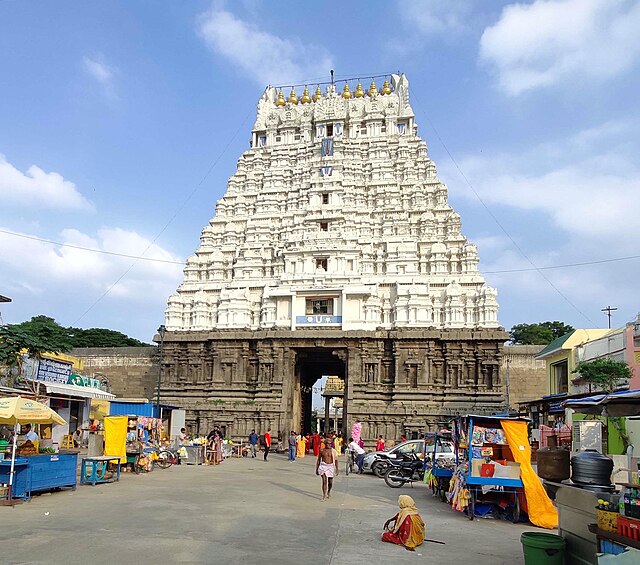

There are two ways to reach Kanchipuram from Chennai, and your choice depends on divine preferences.
If you're Team Vishnu and want to pay your respects at the majestic Varadharaja Perumal Temple, take the route via the airport. It’s smoother, faster, and practically a VIP runway to Vishnu.
But if your heart beats for Lord Shiva—or you're hedging your bets by visiting both deities—then hit the Chennai-Bangalore highway. That route leads you to the famous Mango Tree Shiva Temple and gives you on a spiritual BOGO (Buy One God, Get One Free) kind of experience.
So basically: Vishnu? Fly low via airport. Shiva or both? Go full throttle on the highway!
Now, Varadharaja literally means “wish fulfiller,” so go prepared with a list (and maybe a pen & a notebook for last-minute additions).
People don’t just come here to ask for promotions and peace of mind. They come with burdens, karmic baggage, ancestral debts, and existential dread. This is one of the 108 Divya Desams, and the energy here is potent, ancient, and deeply transformative.
And this isn't just about personal gain—it’s about deep spiritual cleansing. In fact, even Lord Brahma is said to have performed penance here. The belief goes that just a darshan of Varadharaja Perumal can lift you out of cycles of suffering, and wash away bad luck like monsoon rain on dusty streets.
Divya Desams (more about it in another blog) are the 108 temples dedicated to Lord Vishnu that are mentioned in the works of the Alwars—twelve Tamil poet saints who lived between the 6th and 9th centuries CE. Their devotional hymns, collectively known as the Divya Prabandham, are considered the Tamil Vedas (for the Vishnu followers), and they gave these temples an exalted status by singing about them in verses brimming with love, surrender, and mystical experiences.
Out of these 108:
105 are located in India (primarily in Tamil Nadu, with a few in Kerala, Andhra Pradesh, and Uttar Pradesh),
1 is in Nepal (Muktinath)
The remaining 2 are believed to exist in the spiritual realm (yes, even the gods kept a few VIP addresses secret).
Now, let’s visit the temple….
Temple Timings: 6.00 am to 12.30 pm & 4.00 pm to 8.00 pm. 6.00 am to 10.00 pm (On functions and ceremony days)
PARKING: WHERE TO LEAVE YOUR VEHICLE
It’s business as usual. On regular days, there’s parking space available right in front of the temple. However, on crowded days, it’s common practice to drop off visitors near the entrance while the driver finds parking farther away—sometimes a few kilometres out. Once your temple visit is complete, you can call the driver to return and pick you up.
If you’re self-driving, it’s a wise move to park wherever you can and then hop into a tuk-tuk (auto-rickshaw) for the to-and-fro. Saves time, energy, and your sanity.
FOOTWEAR ETIQUETTE & DRESS CODE: TO KNOW BEFORE YOU GO
There is an official footwear kiosk at the Varadharaja Perumal Temple—yes, it’s ear-marked, presumably well-meant, and theoretically functional but don’t be surprised if it turns out to be more of a spiritual metaphor for “self-reliance” than an actual manned facility.
If you think you footwear can inspire sandal envy—it's wiser to entrust them to one of the little shops nearby. They’ll babysit your beloved footwear like it's a pair of Gucci loafers, and all it takes is a friendly tip at the end. Think of it as footwear insurance.
Dress code: Long trousers that cover the ankles and no sleeveless tops are expected. In short—dress modestly, please. You might spot people wandering in with shorts and T-shirts, but temple rules tend to change faster than a monsoon cloud over Chennai. It’s always safer (and more respectful) to err on the side of tradition.
THE TEMPLE: HISTORY, ARCHITECTURE & CULTURAL SIGNIFICANCE
In addition to the characteristic elements of Dravidian temple architecture—such as the gopuram (gateway tower), temple tank, and vimana (shrine tower)—the Varadharaja Perumal Temple in Kanchipuram, Tamil Nadu, is distinguished by a rare and significant event known as the Athi Varadar Utsav. This extraordinary festival, held once every 40 years, is centered around the Athi Varadar, a 10-foot idol of Lord Vishnu intricately carved from the sacred fig tree (Athi tree). The idol is customarily preserved underwater in the temple tank, Anantha Sarovaram, and is ceremoniously brought out for public worship over a 48-day period during the festival.
The Varadharaja Perumal Temple in Kanchipuram, one of the Divya Desams (108 sacred Vishnu temples mentioned in the Alvars' hymns), is not only architecturally grand but also spiritually rich, housing several important shrines of Vishnu & Lakshmi within its vast complex.
One of the most unusual and fascinating features of the Varadharaja Perumal Temple is the Lizard Shrine, affectionately known as the "lizard mandapam”
Note: House lizards, or common wall geckos, are a frequent presence in Indian households. According to traditional beliefs, if a lizard falls on a specific part of a person’s body, it is considered an omen—signifying either auspicious or inauspicious events, depending on the location of contact. In fact, dedicated almanacs exist to interpret these occurrences, known as Gauli Shastra. One of the more ominous interpretations is that a lizard falling on one’s head foretells misfortune or adverse outcomes.
In light of these beliefs, devotees visit the lizard shrine within the Varadharaja Perumal Temple to seek relief from the perceived consequences of such omens. Worship at this shrine is also believed to absolve individuals of the sins of past karma, thereby offering both spiritual purification and protection from ill fate.
According to legend, the disciples of sage Gautama were cursed to be born as lizards, and were relieved of their curse by a touch from Lord Vishnu.
Note: In the following sections, I offer a “Virtual Walkthrough of the Temple, in Words and Images” —a vivid, step-by-step walkthrough that reveals its many facets in words. If you prefer to experience the temple firsthand and let its beauty unfold naturally during your visit, you may wish to skip ahead. For your convenience, I’ve enclosed the virtual tour within red markers.
After depositing your footwear—whether at the official kiosk or under the expert care of the corner shop—you’re greeted by a splendid view of the temple’s modest yet charming gopuram. Unlike the sky-piercing towers of Madurai or Srirangam, this one doesn’t scream for attention. Instead, it quietly commands admiration, both from the outside as you approach, and again from the inside as you look back.
It’s the kind of structure that doesn’t need to be ostentatious to leave an impression—like that quiet topper in school who doesn’t talk much but aces every exam.
The Dwaja Sthambam, mandapam & the sacred tank
As you step through the entrance, you emerge into a vast open courtyard – where temple festivals are held.
Right ahead stands the Dwaja Sthambam (flag pole), tall and dignified like a spiritual antenna connecting earth to the divine broadcast above. To your right, you’ll spot a blessed food kiosk. Just opposite the kiosk, is the elegant Kalyana Mandapam—the ceremonial wedding hall, all pillars and grandeur in granite stone. And tucked behind the mandapam, glinting in the sun, lies the temple tank—Anantha Sarovaram, a serene reservoir that holds not just water but centuries of myths, rituals, and of course, the sacred Athi Varadar idol.
It’s a space that’s equal parts sacred geometry and spiritual logistics—with something to worship, something to eat, and somewhere to cool off.
This is an orthodox temple, where non-Hindus are respectfully restricted from proceeding beyond the flag-pole—the Dwaja Sthambam—a clear line marking the temple’s spiritual sanctum. For those who are permitted to enter, the key elements are the various shrines and the lizard mandapam (that I have mentioned above) to visit, pray, observe and appreciate.
Varadharaja temple tank photo by Ssriram mt from Wikimedia commons licensed under CC by SA-3.0
FESTIVALS & CELEBRATIONS: THE TEMPLE IN FULL SPLENDOR
Athi Varadar Utsav (Once Every 40 Years)
This is the most iconic festival held at the temple. The Athi Varadar Utsav occurs once every 40 years, when the idol of Athi Varadar, a 10-foot wooden statue of Lord Vishnu carved from the sacred Athi tree, is brought out from the temple tank (Anantha Sarovaram) after being submerged for centuries. The festival lasts for 48 days, with the idol being displayed in two postures—reclining for the first 24 days and standing for the last 24 days. The next Athi Varadar Utsav is expected in 2059, making it a once-in-a-lifetime experience for many devotees.
Note: The Athi Varadar idol was the original presiding deity of the temple until the 16th century. To protect it during invasions, the idol was submerged in the temple tank. It was rediscovered in 1709, and since then, the tradition of bringing it out for worship every 40 years has been followed. During the 48-day festival, the idol is displayed in two postures: reclining for the first 24 days and standing for the next 24 days.
Vaikunta Ekadasi (December or January)
One of the most significant festivals in the Vaishnavite calendar, Vaikunta Ekadasi celebrates the day when Lord Vishnu is believed to open the gates of Vaikunta (his heavenly abode) for his devotees. Devotees flock to the temple to seek divine blessings, and the Paramapada Vaasal (the gate symbolizing Vaikunta) is opened for a special darshan, allowing people to walk through it—a practice believed to grant salvation.
Panguni Uthiram (March or April)
This festival marks the celestial wedding of Lord Vishnu (as Varadharaja Perumal) and Perundevi Thayar (his consort). It's an important day for the devotees who gather to witness the symbolic wedding ceremony. The Kalyana Mandapam (wedding hall) becomes the focal point, with special rituals and processions held throughout the day, marking the divine union.
Brahmotsavam ( May 2025)
The Brahmotsavam is one of the most important annual festivals celebrated at the temple, honoring Lord Varadharaja Perumal. This festival spans several days, featuring a series of elaborate rituals, including grand processions of the deity on different types of vahanas (vehicles). Devotees participate in the temple services and processions, offering prayers, flowers, and special offerings.
Rath Yatra (Chariot Festival - May - June)
The Rath Yatra is another grand procession where Lord Varadharaja Perumal is taken around the temple grounds in a massive chariot. The procession is accompanied by music, chanting, and devotional offerings, with thousands of devotees pulling the chariot as a symbolic act of service and devotion.
Margazhi Festival (December-January)
During the Margazhi month, the temple hosts special rituals and celebrations, coinciding with the Tamil Isai Festival, where temple choirs perform devotional songs. Devotees participate in singing devotional hymns and taking part in early morning prayers, especially during the Thiruppavai recitations, which are sacred to the Alvars.
Tamil New Year (Puthandu April)
The Tamil New Year marks the start of the Tamil solar calendar and is an important day for devotees to seek blessings from Lord Varadharaja Perumal for a prosperous year ahead.
Special pujas and rituals are conducted, and the temple is beautifully decorated for the occasion.
PHOTOS: WHAT’S ALLOWED, NOT, ANGLES, LIGHT & GOLDEN HOUR
EXPLORING THE SURROUNDINGS: AROUND THE TEMPLE COMPLEX
When it comes to exploring the surroundings of the Varadharaja Perumal Temple, don’t expect a bustling, touristy area with endless options for shopping or sightseeing. The temple is nestled in a more tranquil part of Kanchipuram, where the immediate surroundings are relatively calm and serene.
There’s not much in terms of grand attractions right around the corner, so if you're hoping for a full-on adventure, you might need to venture a little further out into the city.
If you're in need of a snack or a break, though, you can always find a small local café or shop for quick refreshment before you get back to exploring other parts of the town.
AMENITIES & PUBLIC FACILITIES FOR VISITORS
Modest squat pay & use facility which you may want to use only if you need to urgently. If you are, don't forget to take your paper roll. Otherwise find a café near-by.
SHOPPING & ESSENTIALS: WHAT TO BUY AND WHERE
Shopping around the Varadharaja Perumal Temple is a more laid-back affair compared to the bustling markets of larger tourist destinations. The area surrounding the temple is dotted with small shops where you can find traditional items typically linked to temple rituals and local crafts. For serious shopping of Silk, other fabrics or lunch etc., you need to go to the town.
WHY JUST READ IT WHEN YOU CAN LIVE IT? COME EXPLORE WITH ME!
With over two decades of experience in curating unforgettable journeys, we specialize in organizing tours across India, Southeast Asia, and select European destinations. Let us take you beyond the guidebooks and into the heart of each place we visit. Come travel with us—your adventure begins here.
Photo angles and perspectives are business as usual in this temple too as discussed above for other temples. However, in this temple beyond the first open corridor, photography is strictly prohibited as of writing this blog. Ensure if any part of temple is OK to photograph when you actually visit the place.
